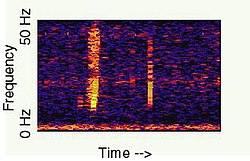Bloop: Difference between revisions
| Line 10: | Line 10: | ||
==Analysis== |
==Analysis== |
||
The sound, traced to somewhere around [http://stable.toolserver.org/geohack/geohack.php?pagename=The_Bloop_(unidentified_sound)¶ms=50_S_100_W_scale:40000000 50° S 100° W] ([[South American]] southwest coast), was detected repeatedly by the Equatorial Pacific Ocean autonomous hydrophone array, which uses [[United States Navy|U.S. Navy]] equipment originally designed to detect [[Soviet]] [[submarine]]s. According to the NOAA description, it "rises rapidly in frequency over about one minute and was of sufficient amplitude to be heard on multiple sensors, at a range of over 5,000 km." According to scientists who have studied the phenomenon it matches the audio profile of a living creature but there is no known animal that could have produced the sound. If it is an animal, it would have to be, reportedly, much larger than even a [[Blue Whale]], the largest known animal on the earth.<ref>[http://archives.cnn.com/2002/TECH/science/06/13/bloop/ CNN.com - Tuning in to a deep sea monster - June 13, 2002<!-- Bot generated title -->]</ref> |
The sound, traced to somewhere around [http://stable.toolserver.org/geohack/geohack.php?pagename=The_Bloop_(unidentified_sound)¶ms=50_S_100_W_scale:40000000 50° S 100° W] ([[South American]] southwest coast), was detected repeatedly by the Equatorial Pacific Ocean autonomous hydrophone array, which uses [[United States Navy|U.S. Navy]] equipment originally designed to detect [[Soviet]] [[submarine]]s. According to the NOAA description, it "rises rapidly in frequency over about one minute and was of sufficient amplitude to be heard on multiple sensors, at a range of over 5,000 km." According to scientists who have studied the phenomenon{{Fact|date=December 2008}} it matches the audio profile of a living creature but there is no known animal that could have produced the sound. If it is an animal, it would have to be, reportedly, much larger than even a [[Blue Whale]], the largest known animal on the earth.<ref>[http://archives.cnn.com/2002/TECH/science/06/13/bloop/ CNN.com - Tuning in to a deep sea monster - June 13, 2002<!-- Bot generated title -->]</ref> |
||
==In popular culture== |
==In popular culture== |
||
Revision as of 17:59, 23 December 2008
50°00′00″S 100°00′00″W / 50.000000°S 100.000000°W

The Bloop is the name given to an ultra-low frequency underwater sound detected by the U.S. National Oceanic and Atmospheric Administration several times during the summer of 1997. The source of the sound remains unknown.
Analysis
The sound, traced to somewhere around 50° S 100° W (South American southwest coast), was detected repeatedly by the Equatorial Pacific Ocean autonomous hydrophone array, which uses U.S. Navy equipment originally designed to detect Soviet submarines. According to the NOAA description, it "rises rapidly in frequency over about one minute and was of sufficient amplitude to be heard on multiple sensors, at a range of over 5,000 km." According to scientists who have studied the phenomenon[citation needed] it matches the audio profile of a living creature but there is no known animal that could have produced the sound. If it is an animal, it would have to be, reportedly, much larger than even a Blue Whale, the largest known animal on the earth.[1]
In popular culture
- Because the Bloop noise originated near the location of the fictional sunken city of R'lyeh from H. P. Lovecraft's story "The Call of Cthulhu", the Bloop has been linked to Cthulhu by Lovecraft fans.[2]
- In the alternate reality game promoting the movie, the Bloop was also linked to the monster from Cloverfield.[3]
- The Bloop was seen in The Loch by Steve Alten as the call of an undiscovered species of giant eel,[4] as well as in Frank Schätzing's novel The Swarm as the speech of the intelligent species, the Yrr.[5]
- The title track from Dntel's 2001 album Life Is Full of Possibilities repeats a sample of the Bloop sound set to music.
See also
References
- ^ CNN.com - Tuning in to a deep sea monster - June 13, 2002
- ^ Howstuffworks: "The Cthulhu Mythos"
- ^ Cloverfield Movie Blog
- ^ The Loch by Steve Alten
- ^ The Swarm
- http://www.theage.com.au/articles/2002/06/13/1023864318809.html
- http://archives.cnn.com/2002/TECH/science/06/13/bloop/
- http://archives.cnn.com/2001/TECH/science/09/07/listening.ocean/
External links
- "Bloop" NOAA Vents Program for Acoustic Monitoring. Has a link to a wav file of the (sped up) sound, as well as a spectrogram.

